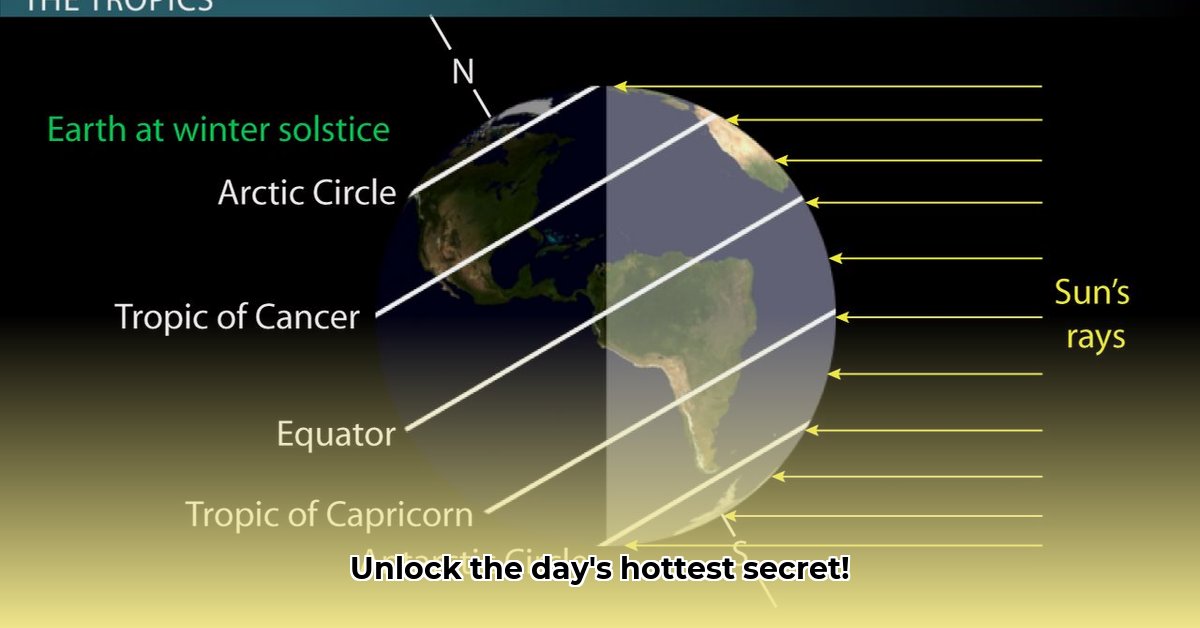
Hottest Part of the Day Explained
Why Isn't It Hottest at High Noon? The Mystery of Thermal Lag
Most people assume the hottest part of the day is when the sun is directly overhead—solar noon. However, this is often incorrect. The Earth's surface doesn't heat up and cool down instantly; there's a delay, known as thermal lag. This lag means the peak temperature typically arrives three to five hours after the sun reaches its highest point. Think of a beach; the sand takes hours to scorch, staying warm long after sunset. This seemingly simple delay has significant implications, influencing everything from agricultural practices to energy grid management. For a deeper dive into this phenomenon, check out this helpful article: Learn More.
Unpacking Thermal Inertia: How the Earth Heats Up (and Cools Down)
"Thermal inertia" refers to the resistance of a substance to temperature changes. Imagine heating a thick iron skillet; it takes time to heat up and remains hot even after removing it from the heat. The Earth behaves similarly. It gradually absorbs solar energy (radiation) and releases that stored heat over several hours. The heat transfer occurs through conduction (direct contact), convection (air movement), and further radiation. This process, not instantaneous, explains why the peak temperature occurs after solar noon. Even after sunset, the Earth continues to radiate absorbed heat.
Beyond the Sun: Other Factors Affecting Our Daily Highs
While solar radiation is the primary driver, other factors significantly influence the timing of the daily peak temperature:
- Cloud Cover: Clouds act as a natural insulator, reducing solar radiation reaching the surface, thus delaying the warming process and peak temperature.
- Wind: Wind acts like a giant fan, distributing heat and potentially lowering the peak temperature. Stronger winds lead to faster cooling.
- Albedo (Surface Reflectivity): Dark surfaces (low albedo) absorb more solar energy than lighter surfaces (high albedo). This means areas with dark surfaces, like asphalt, will heat up faster than those with lighter surfaces, such as sand or snow.
- Geographic Location: Coastal areas experience less temperature variation than inland regions due to the ocean’s thermal inertia (its ability to retain heat). Altitude also affects temperatures; they usually decrease with elevation. Isn't it remarkable how many variables influence our daily temperatures?
The World's Diverse Daily Temperature Patterns: A Global Perspective
A desert experiences more dramatic temperature swings than a coastal city. Deserts, lacking moisture and with vast expanses of dark sand, exhibit low thermal inertia. The peak temperature arrives later and is much higher than in coastal cities. In contrast, the ocean's high thermal inertia moderates temperature changes. Latitude plays a role, too. Equatorial regions experience consistent daily temperature variations, while higher latitudes experience greater seasonal variations and changing peak temperature times.
Practical Applications: Who Needs to Know When It's Hottest?
Understanding the timing of peak daily temperatures is crucial for various sectors:
- Meteorological Services: Accurate prediction improves weather forecasts and heatwave warnings, enhancing public safety.
- Agriculture: Farmers use this knowledge to optimize irrigation, reducing water waste and improving crop yields. Knowing the peak heat allows protection against heat stress.
- Energy Sector: Peak temperature predictions help in optimizing energy grid management, preventing power outages during peak electricity demand.
Key Takeaways:
- Thermal Lag is Key: The hottest time is typically 3-5 hours after solar noon due to thermal lag.
- Multiple Factors Influence Timing: Cloud cover, wind, albedo, and geographical location modify the peak temperature timing.
- Geographical Variations Are Significant: Coastal areas experience milder variations than inland regions due to the ocean's thermal inertia.
The timing of the daily peak temperature is not simply about when the sun is highest. It is a complex interaction of various factors, with thermal inertia playing a central role. Understanding these intricacies improves temperature predictions, enhances resource management, and aids adaptation to daily and seasonal temperature changes.